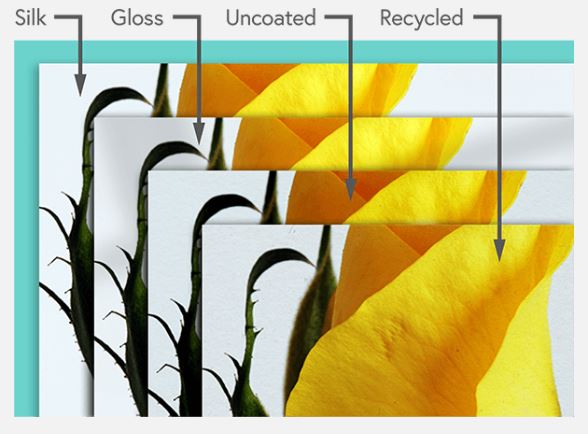Our Paper Range
The quality of paper is important for printed products. Printed items are often the first way someone comes into contact with your brand, product, service, or event. It’s important to select the right paper type and weight for your design, purpose, and budget.
Paper Types
Silk
Silk is our recommended default choice for the very best results. It’s a coated paper with a satin finish and a slight sheen. Silk is suitable for print jobs containing text and pictures, makes printed colours appear bright and well defined, and is great for readability. If in doubt, choose silk.
Gloss
Gloss is a coated paper with a high shine. Printed colours appear bright and vivid on gloss paper, making it ideal for displaying striking images and photographs in colour.
Uncoated
Unlike gloss or silk, this paper does not have a coating, which gives it a very soft finish. The ink sinks into the paper, giving the colour a more understated appearance. Uncoated paper is a great choice for stationary or postcards, since it’s easy to write on and has a prestigious look and feel.
Natural
This is an uncoated paper that has all of the characteristics of uncoated paper, but has not been treated to make it as white as possible. Instead, it has a natural off-white colour. Natural paper is a perfect choice for a more vintage or rustic look.
Recycled
As the name suggests, this consists of 100% recycled paper. Recycled paper saves trees, and also saves more than 70% of the energy and water used in traditional paper production. It has a natural look but is still very white.

Paper Weights
What is gsm?
The term ‘gsm’ is an acronym for ‘grams per square meter’. The higher the gsm number, the heavier the paper.
90-115gsm
This is a lightweight paper that is good if you’re on a tight budget or are sending your prints through the post (the paper is lighter, so the postage will cost less).
Most magazines are printed in this range. Letterheads tend to be printed around 115gsm.
130-170 gsm
This is our most popular paper weight range. At 130gsm, you’ll no longer get any show through (where you can see the print from the other side of the page).
This weight range can be used for brochures or magazines, since the paper is strong enough to support the stitching.
250-450gsm
Paper in this weight range is thick and has a more premium feel. It’s perfect for covers, certificates, and high-end flyers and leaflets.
Paper in this range can be laminated, but it can only be folded if it’s scored first.
Paper Sizes
Our products are displayed in standard A sizes and a range of the most common and popular sizes. If your project calls for something a little bit different, that’s absolutely fine! Contact us and we’ll provide you with a quote for a custom size. Not sure which paper size to choose for your project? See our list of industry standard sizes.
Cover Papers
Cover papers add a front and back cover to your booklet. To add a cover, select ‘Add Cover’ in the price calculator and choose your cover paper type, weight, and finish.
The heavier the weight of your cover paper, the more rigid the booklet will be. We don’t advise adding a thick cover to booklets with low page counts, as it forces the booklet to stay open.
Some customers choose a thinner cover to give their booklet more flexibility, while others choose not to have a cover at all. This is often called a ‘self cover’ or ‘floppy cover’, since with this option the booklet is very flexible.
Note: only cover papers can be laminated.
Suitability
We offer a wide range of paper weights, but not all options are suitable for every product. But don’t worry–our cost calculator is very advanced, and it won’t let you choose an unsuitable option.
Your available suitable options may also change depending on whether your order is going to be printed on a digital or litho press. Our system always makes sure that your options fit the printer being used for your order.
Some products, like letterhead stationary, are made with uncoated paper, so you can print on the paper with your desktop printer. Digital uncoated paper can’t be overprinted on with a desktop printer. That’s why all of our letterheads are printed using a litho press.
Upgrading And Variations
On occasions, when the time comes to print an order, we may find the particular requested paper weight out of stock. Rather than delay your order, we will often print it on the next weight up. This is called ‘upgrading’ and is quite common in the industry.
Most of the time it is not an issue, but if your item is going to be sent by post, upgrading the paper can affect the postage cost.
If paper weight is of great importance to your order, please let us know before we go to print.
We do not charge extra if we need to upgrade your paper, and we never downgrade paper.
Variations in paper production
Paper is a natural product, supplied from the mill in batches. As such, there can be variations in weight or thickness from one batch to another. This can result in paper that is up to 10gsm heavier or lighter.
We may also buy our paper from different merchants at different times, which can also lead to small variations in our paper stock.
Environmentally Friendly
We’re passionate about the environment here at YouLovePrint, and we do our best to source materials that have a minimal environmental impact.
We’re also working hard to make sure that we leave the lightest possible carbon footprint in everything we do.
For example: